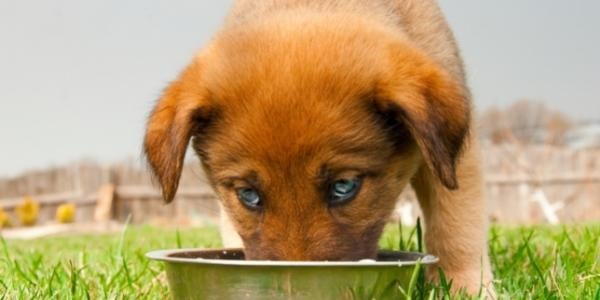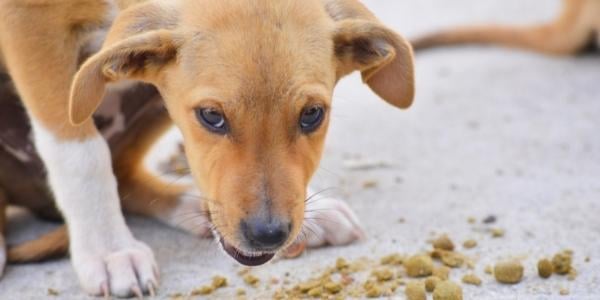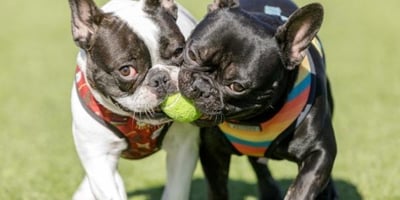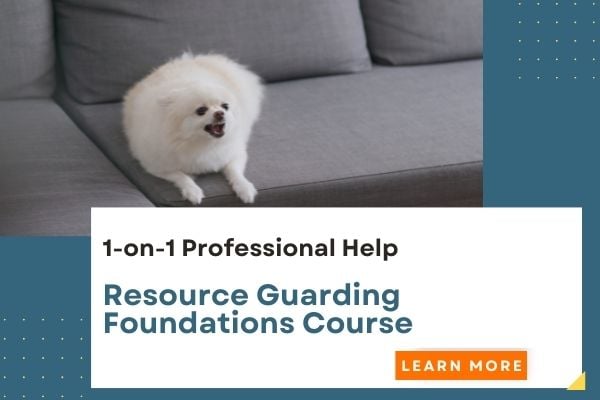 Have you brought home a new puppy and are wondering about how to make sure they don't guard their food bowl?
Have you brought home a new puppy and are wondering about how to make sure they don't guard their food bowl?
Can you even stop resource guarding before it ever becomes a problem?
Resource guarding, or "possessive aggression," is a scary problem. This behavior can range from subtle warning signs like freezing, wide eyes, and crouching over something to lunging, snapping, and biting.
If you've experienced resource guarding with a previous dog, you may be feeling extra sensitive and cautious with your new dog and want to do anything you can to prevent it from developing.
If you're worried about your new puppy or young adopted dog showing resource guarding behavior around their food, toys, or space, there are a few things you can do to stop it from becoming a larger problem. In fact, the prevention of resource guarding closely resembles the actual treatment steps for resource guarding.
The most important thing is teaching your dog that they can trust you.
Table of Contents
Can Resource Guarding in Dogs Be Prevented?
Preventing Resource Guarding is All About Building Trust
The first thing to consider is that resource guarding is a normal and natural canine behavior. Protecting one's resources proved quite advantageous for dogs throughout their history. It is instinctual to protect valuable resources in order to survive — dogs need to find food and then keep others from taking it. Humans do it. Dogs do it. But can you prevent instinctive behavior?
While it may be a natural canine behavior, resource guarding becomes an issue when it puts people or other pets at risk of injury. It hints at the larger problem of a dog's lack of trust with other family members.
I believe that we can certainly do things to prevent resource guarding tendencies from becoming a dangerous behavior issue. The most important thing is teaching your dog that they can trust you. That you aren't arbitrarily going to take things away from them. And that if you take something away, they'll get something equal or better in return. It's all about creating the right associations for your new puppy.
How Human Behavior Affects Resource Guarding
Preventing resource guarding in dogs has a lot to do with human behavior and ensuring that we aren't inadvertently teaching them to guard their food, toys, or other things. Unfortunately, there are things that humans do that can make resource guarding worse, such as playing with a dog's food while they're eating or constantly grabbing at their toys and chews just because we can. Preventing resource guarding in your puppy is not only about teaching your puppy how to feel and what to do but also about people learning what not to do!
How to Prevent Resource Guarding in Puppies
Counterconditioning: Teach Your Puppy that Your Approach = Great Things!
Start the options below from the moment you bring your puppy home. You don't want to wait until your puppy is already exhibiting signs of resource guarding. Prevention is key!
When your puppy is eating their meals or enjoying a chew or toy, you should incorporate both of the following options into your routine:
- Let them eat or chew in peace.
- Walk by where they are eating or chewing and calmly toss a high-value food treat to them.
When practicing option two, start tossing the treat to your puppy from a few feet away. This is called counterconditioning. Don't rush into their space or reach for the item or bowl when you first do this exercise. Stop a few feet away, toss the treat, and then move away.
The idea here is that your puppy learns that you won't bug them when they are eating and that when you do approach, yummy things fall from the sky! Things that are even better than their food, toy, or chew. This creates a positive emotional response.
After a few practice sessions, you'll start approaching a bit closer before tossing the treat. Then practice stopping and standing right by your puppy's bowl, dropping the treat, and then walking away. Over time, you can add more intrusive steps, such as reaching down towards the bowl, touching the bowl, slightly lifting the bowl, etc. before dropping the treat.
If at any point you notice your puppy getting stiff, start to eat or chew faster, or show other signs of resource guarding, stop and move away. Let them finish in peace and then the next time you practice, start at an earlier step. Go at your puppy's pace!
This video from Kikopup shows how to do this exercise to prevent toy guarding in puppies:
Play the Counting Game
Games are a great way to train your pup because training should be fun! The Counting Game, created by Chirag Patel, is a popular option to prevent resource guarding in puppies. I also use this game for dogs already exhibiting resource guarding. For This game also teaches your dog to bring something over to you.
It's pretty simple — it's just counting and dropping treats. Have a pocket full of medium to high-value treats. When your puppy has a toy or edible chew, move to a few feet away. Start counting out loud each treat that you drop to the floor.
You may only get to 2, or maybe you get to 15 before your puppy realizes that you're having a treat party and comes over. Let them eat the treats and praise.
Then move a few feet away and repeat. As you go, move closer to their toy or chew, but don't touch it or pick it up. Leave it be! This teaches your puppy that they won't lose something they value when you're around, and, in fact, they get yummy things when you're around resources. It's all about that positive association.
You may notice that your puppy starts bringing their chew or toy with them as they come over to eat the treats. That's great! Avoid the temptation to touch it. After five to six repetitions, then end the game and let them return to their toy or chew.
See how it's done in this video from Noble Woof:
Don't Play with Your Puppy's Food
How would you feel if you were trying to enjoy a meal and someone kept touching your food or pulling your plate away? Playing with or touching your dog's food while they eat has no training benefit. In fact, it can cause an increase in resource guarding.
While you may think you're teaching tolerance, your puppy will see it as just plain rude and irritating. In fact, it can backfire pretty quickly and create a negative emotional response to your presence around food. And when a dog anticipates you touching or taking food away, they'll start to react with guarding behaviors to try and make it stop.
To ensure your puppy can eat in peace, you may need to feed them in a secure and separate area. This is especially important if you have young children in your home. Feed your puppy in their crate or playpen, or put up baby gates to block access to the room they are eating in.
This short and cute video shows why it's important to not play with your puppy's food:
Practice Drop It and 'Positive-Sum' Trades
Having a solid drop it cue means you won't ever find yourself on the losing side of a game of keep-away with your puppy. It also means that your puppy will know that dropping something when asked results in awesome things!
My favorite method for teaching drop it is the association method. This is a bit different from the typical trade technique. Why is it better? Well, you can start training it before your dog even has anything in their mouth!
Chirag Patel shows how to teach drop it with the association technique in this video:
Learn more tips and methods in my article Teach Your Dog to Drop It.
Whenever you practice the traditional trading method with your dog, be sure to make it a positive-sum trade. This means that your dog always gets something equal to or better than what they gave up! For example, I may ask my dog to drop one of his dental chews. When he does, I give him 10 small pieces of chicken in a row – and then I even give him back his dental chew. I want him to think, "I'll drop this thing I love because she always gives me something better!"
Don't 'Treat and Snatch'
Dogs are smart and dogs are fast. If you're practicing taking something away from your puppy, it's important not to accidentally teach them that you giving them a treat means you are about to take what they had away from them. This can happen if you toss a treat to lure them away from a toy or chew, and then quickly grab the thing away.
They'll catch onto this trick pretty quick and usually will take their item and move away from you or be less likely to leave the thing behind to go get the treat the next time. Don't try to trick your puppy or snatch the item away. This breaks down trust. Instead, move more slowly and use more treats!
When you approach your puppy's resource, toss a treat. Then toss another, not touching the item they left behind yet. Continue tossing treats, one at a time, and slowly move closer to the item. As they stay engaged chasing tossed treats, slowly remove the item. Then you can either give the item back to them or put it away. This way, you're not drawing attention to the fact that you're taking the thing from your puppy. See how it's done in this video:
Use the "Naughty Dog" Hack
Preventing resource guarding is all about creating positive experiences with your puppy around their prized items. Kim Brophey, author of Meet Your Dog, created the Naughty Dog Hack as a fun and effective way to build trust and discourage guarding.
When your puppy picks up one of their toys or acceptable object, pretend it’s the most exciting thing ever! Playfully chase them or act like you want it, turning the interaction into a game. This lighthearted approach satisfies their natural play instincts and reinforces positive social dynamics. Here's a video of one of my clients playing this game with their dog Darcy:
For more details, you can download the Naughty Dog Hack PDF here and embrace the fun of managed mischief!
Should You Hand Feed Your Puppy to Prevent Resource Guarding?
I don't typically recommend hand-feeding a dog to either prevent or treat resource guarding. There are simply better ways to prevent resource guarding, and I feel that hand-feeding creates an imbalance in a relationship and can damage the trust we want our puppies to have in us.
Dogs need food to survive, and if someone is super controlling over when and how they get food, it can cause distrust and wariness and remove their ability to make a choice. We already control so much of our dogs' lives, so allowing them time to eat their meal unbothered and freely is important. Instead, I recommend the counterconditioning, as explained above.
That said, hand-feeding occasionally can be beneficial for other reasons. I often recommend people use a portion of their dog's daily meals as training treats because it reduces calorie intake. Hand-feeding can also be helpful for picky eaters. But feeding by hand is not my go-to for preventing resource guarding.
How to Prevent Resource Guarding Between Dogs
When you have more than one dog in your home, you'll want to set them all up for success regarding access to resources. Resources trigger the majority of dog-dog aggression, whether that's food, chews, toys, space, or even attention from people. And dog-dog aggression issues are often the toughest to resolve. Prevention is much easier than treatment!
Management & Supervision
To prevent resource guarding, feed or give high-value chews to your dogs in separate areas. This way a dog won't feel any "pressure" from the other dog, allowing them to relax and eat their meal or enjoy their chew. I often see dogs who are fed close to each other and may not exhibit full-blown resource guarding, but they do exhibit subtle signs of stress, such as eating faster than they would normally.
My younger dog has resource-taking tendencies, which are related to resource guarding. To allow my older dog peaceful meals and reduce her stress, I feed my younger dog in his crate, and the other eats in the kitchen. As time has progressed, I've continued to feed Fozzie in his crate but have started leaving the crate door open. When he finishes his work-to-eat toy, he will come out of his crate on his own and watch Sookie finish her meal from across the room.
This is where supervision is important. I'm there to prevent him from dashing towards her to take her food. If he starts to encroach on her space, I simply stand up and calmly block his way. If he watches from afar, I reward him by praising and tossing him a treat. I want to positively reinforce calmly watching my other dog eat, which is an incompatible behavior with rushing in and taking her food toy. But I would never allow them to freely roam during mealtimes without my direct supervision. That's asking for a confrontation.

Carefully Manage Play Between Dogs
When your dogs are playing together and there are toys involved, you'll want to watch carefully for inappropriate stealing or guarding of toys. Having multiple toys available can help, although often, it can feel like one dog only wants the toy that the other has. Each dog should have their own fetch toy to chase, and you can toss them in different directions to help prevent them from going head-to-head over one.
If one dog starts pestering another over getting a toy and doesn't listen to appropriate warnings, simply stop playtime and give them a break. Another moment to step in is if a dog escalates their guarding behaviors and is willing to fight over keeping the toy.
Remember – resource guarding is a natural dog behavior, so it's not abnormal (or something to necessarily worry about) if you see some low-level "ritualized" guarding behaviors between dogs over toys during play. Ritualized means they're mostly bluster but no bite. They may exhibit behaviors to warn off the other dog but don't want to spend the energy to actually fight over the resource. Either way, I'm always carefully managing dog play so there's no miscommunication or dangerous escalation.
Learn more tips on how to manage dog-dog play here.
Here's a video example of ritualized low-level guarding behavior between two dogs. My dog Sookie, the Cardigan Welsh Corgi, tells Clover, the Portuguese Water Dog, to back away from her and the chew. I'm allowing the interaction to continue because it's all appropriate communication. Neither is escalating their behavior, and Clover responds appropriately by moving away. I'm still closely supervising and ready to intervene if Clover doesn't listen to the warnings or if Sookie escalates needlessly.
Play the One-for-You, One-for-You Training Game
I love this game because it teaches dogs to wait their turn and has counterconditioning benefits. By creating a predictable sequence of events, a dog learns that another dog getting something predicts something good for them, too!
Dog A gets a treat = then Dog B gets a treat. And vice versa.
You can switch up the order in which the dogs get the treat – but if you have one dog who seems more intense about guarding or taking, then they should more regularly be "second in line."
You can play this game with food treats, but you can play it using attention, petting, or toys as the reward.
Training Tip: When you start playing this game, maintain some distance between the dogs. This way they aren't right in each other's faces around resources. You'll notice in the video below that I move my younger dog, Fozzie, further away from my other dog halfway through. I do this because I want him to succeed, and I know if he's too close, he'll dive in and steal Sookie's treat because he's still learning the game.
Teach Alternative Behaviors
Consider whether you want to teach your dogs to do a specific behavior whenever they see the other dog get something. For example:
- When Dog A is given a bully stick, that is a cue for Dog B to go to place.
- When Dog A receives attention from you, Dog B sits and stays.
This is more of a "college-level" training exercise, so having the guidance of a certified dog trainer will go a long way in helping you succeed with this process. The idea is that the cue is not verbal — it is environmental. It takes repetition, but it's a great way to get ahead of resource guarding between dogs.
Overall, counterconditioning and building trust can prevent resource guarding in puppies. Counterconditioning is crucial as it teaches a puppy how to feel when their things are approached and increases the level of trust your puppy has in you. Prevention is the best cure!
Do Puppies Outgrow Resource Guarding?
Puppies will not simply grow out of resource guarding on their own. They need guidance and help to learn new associations and how to better respond in those scenarios.
If your puppy is already exhibiting worrisome signs of resource guarding, it's important to connect with a certified behavior consultant as soon as possible. Treatment of resource guarding is much easier if addressed at an earlier age, as a young dog hasn't had as much time to practice the behavior.
The sooner you begin working on it, the better! Check out my Resource Guarding Foundations Course, which offers options for self-paced training or in-depth coaching support to prevent it from becoming a lifelong problem.




